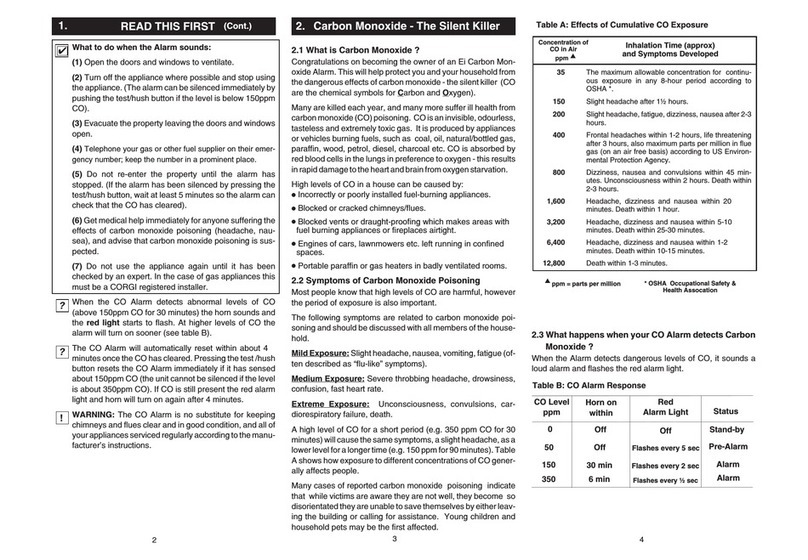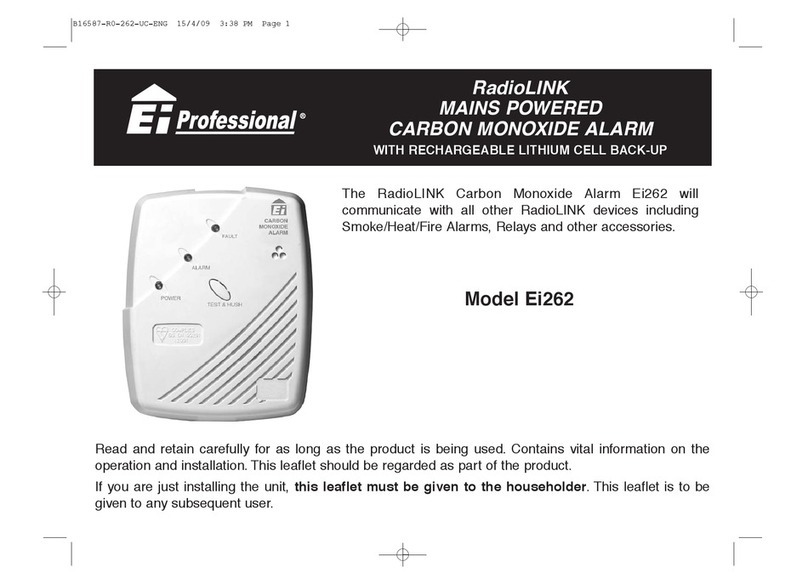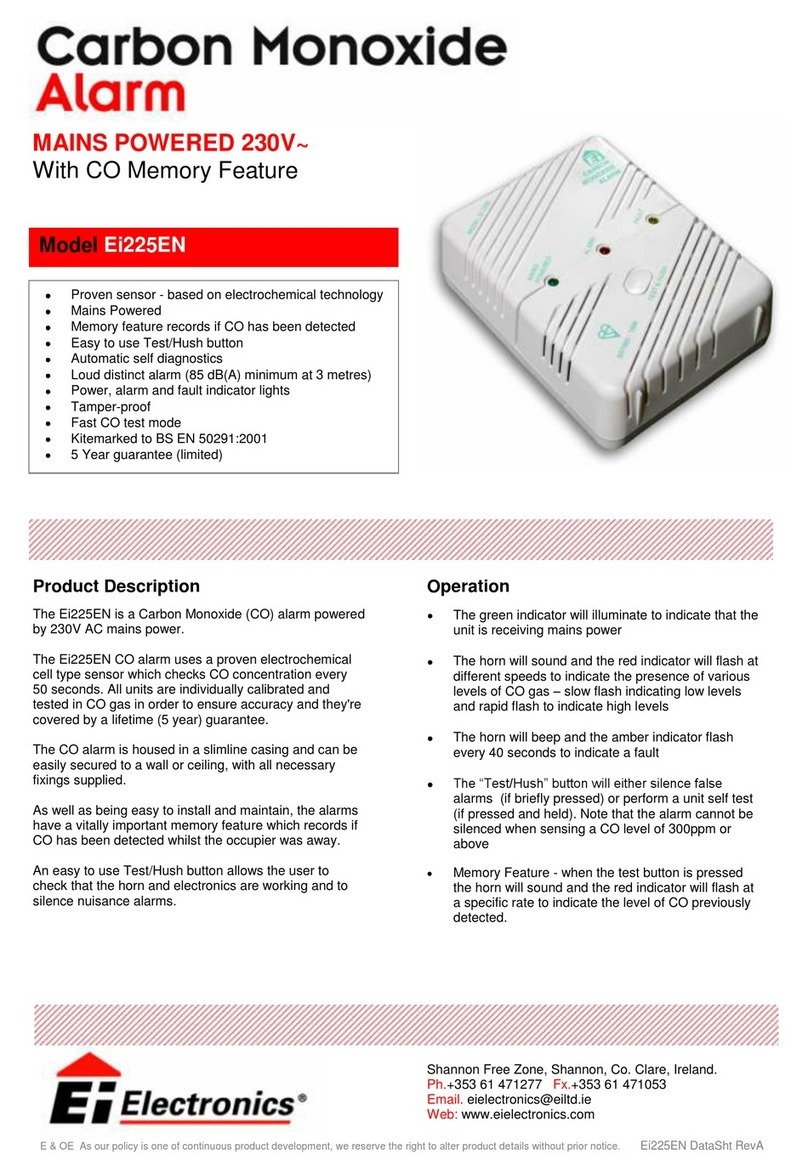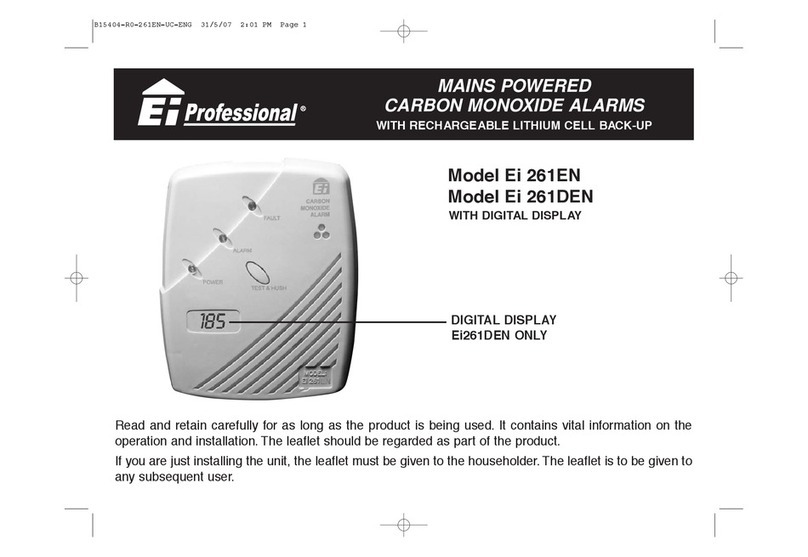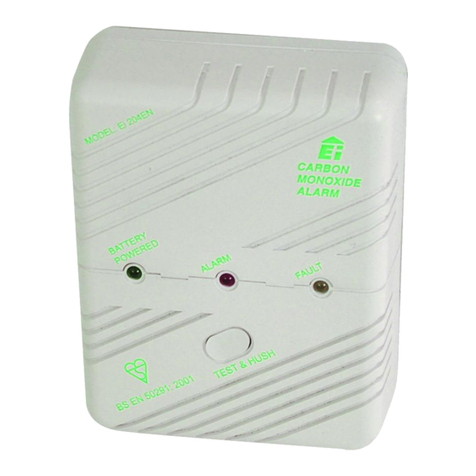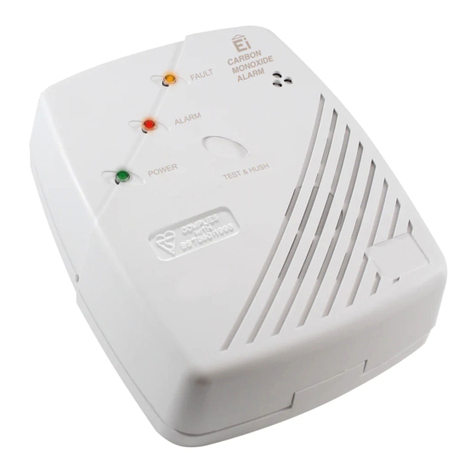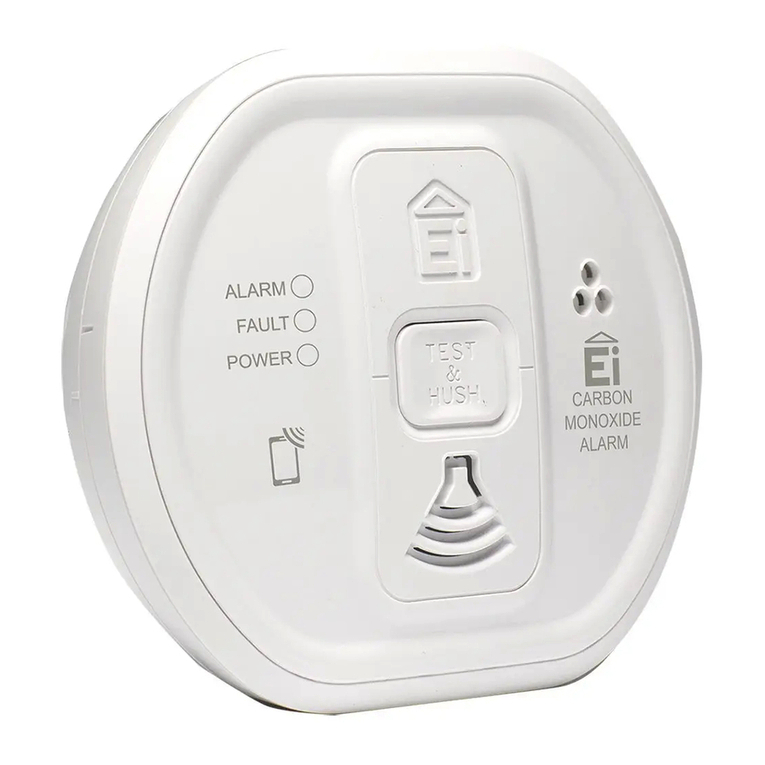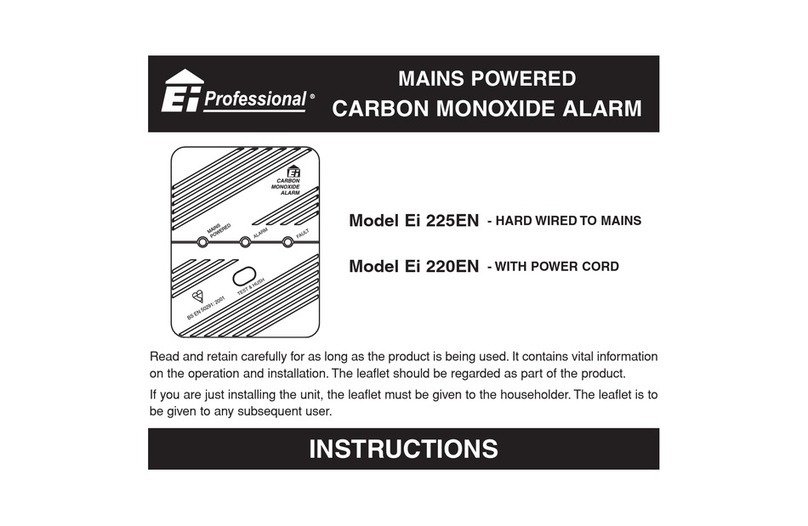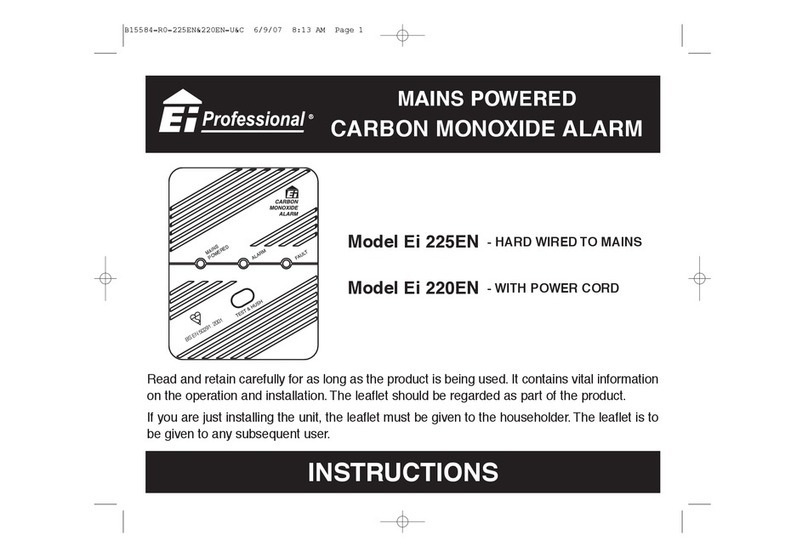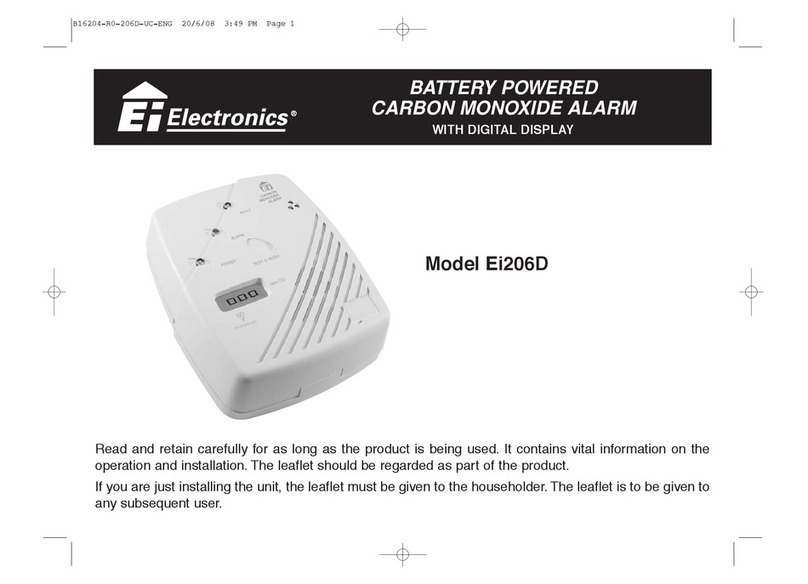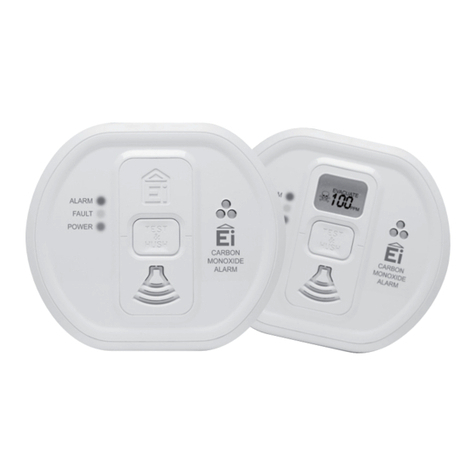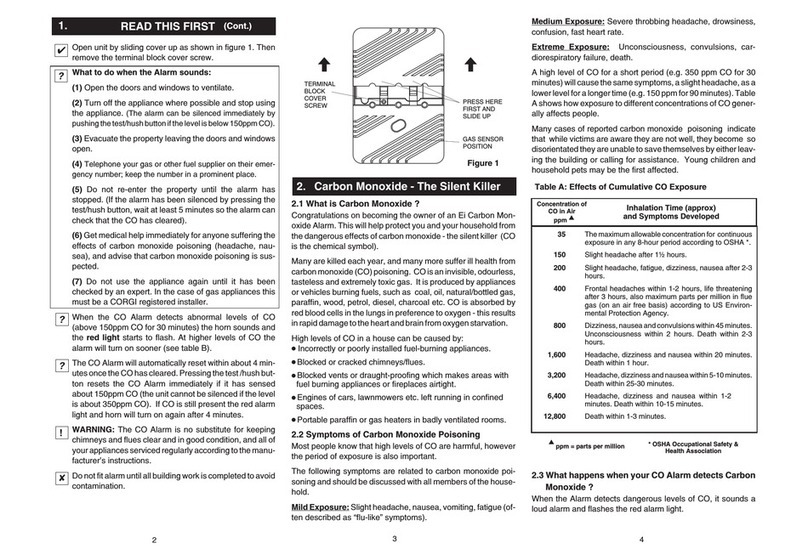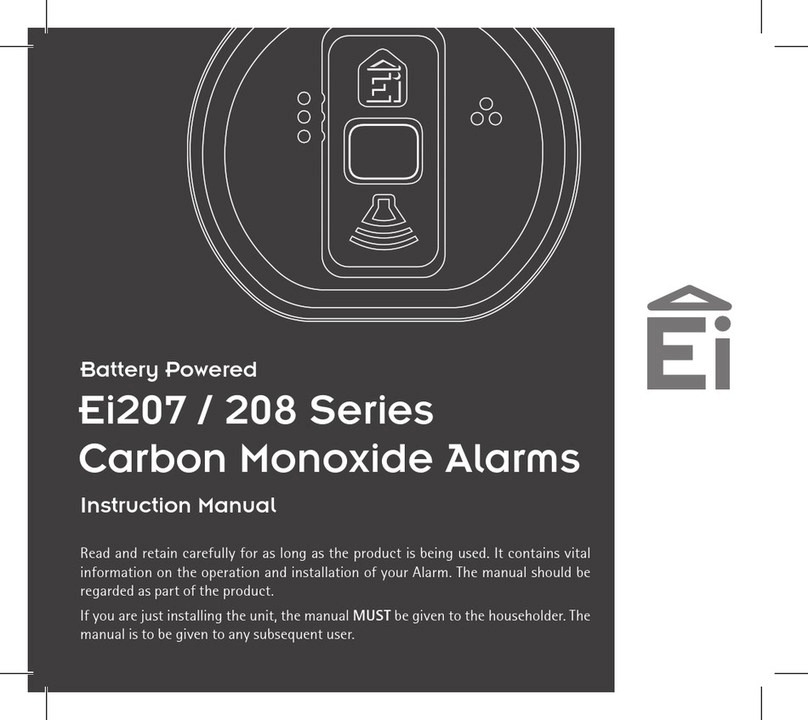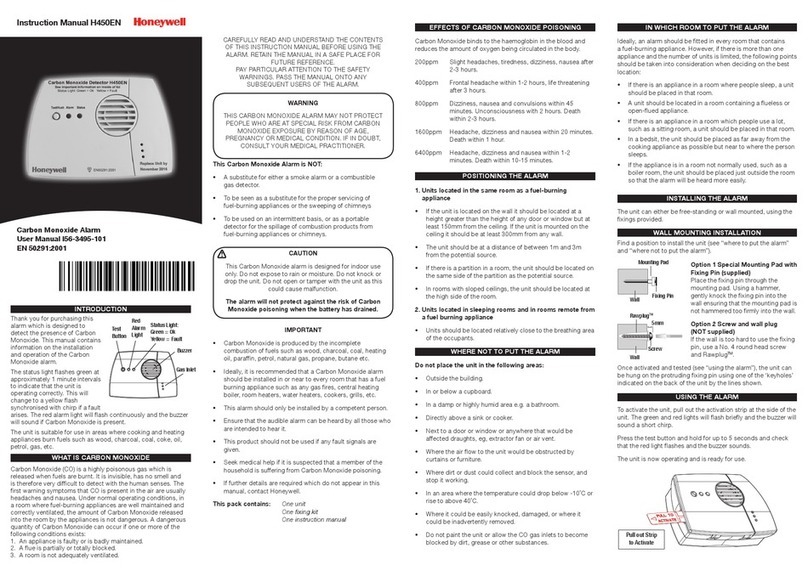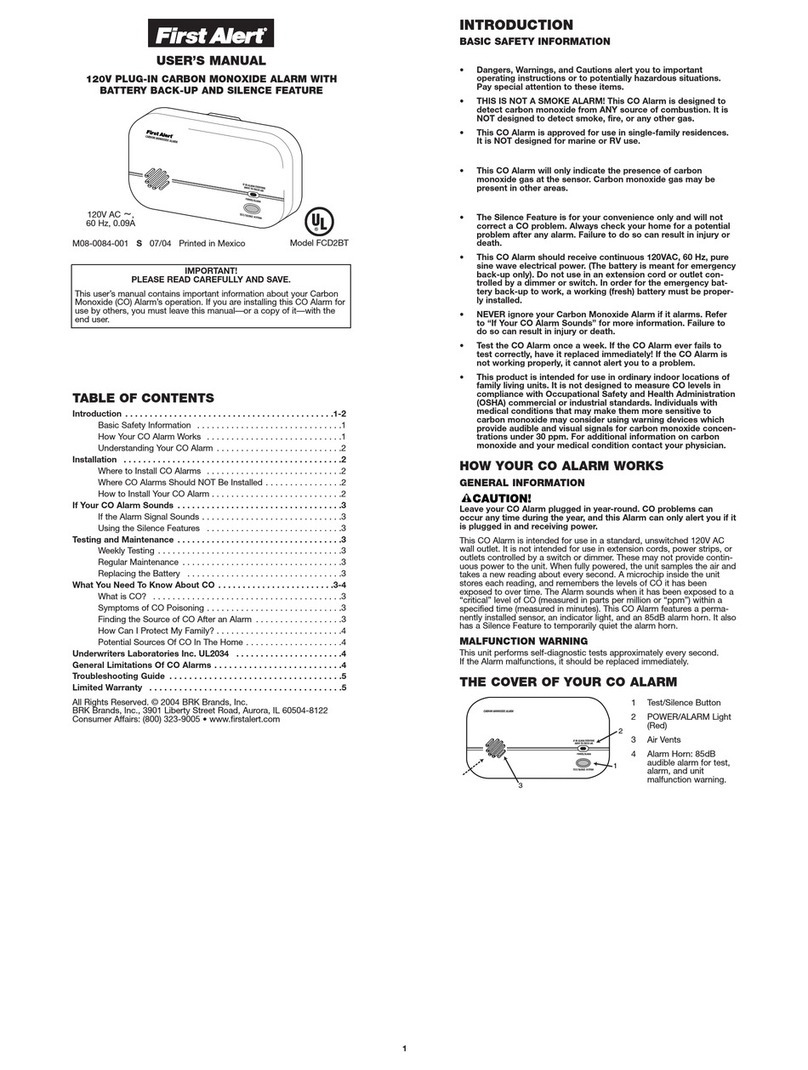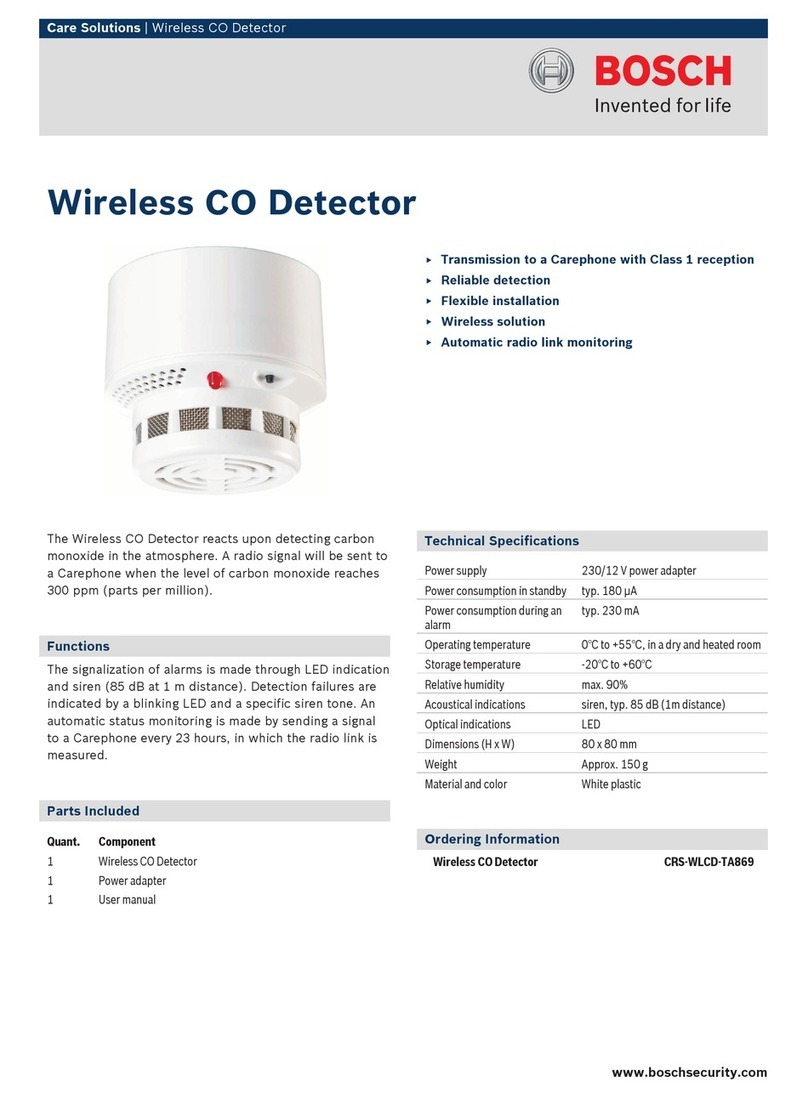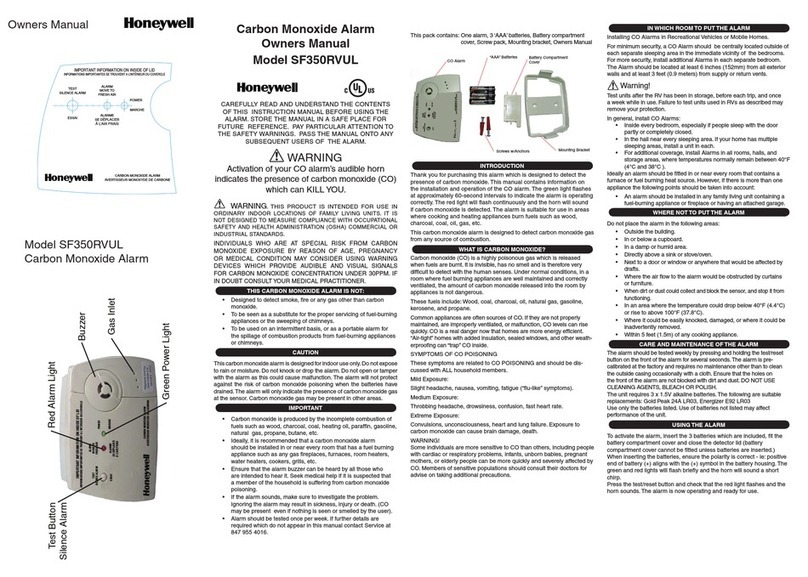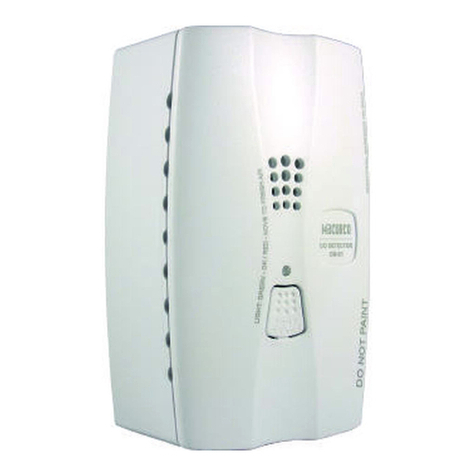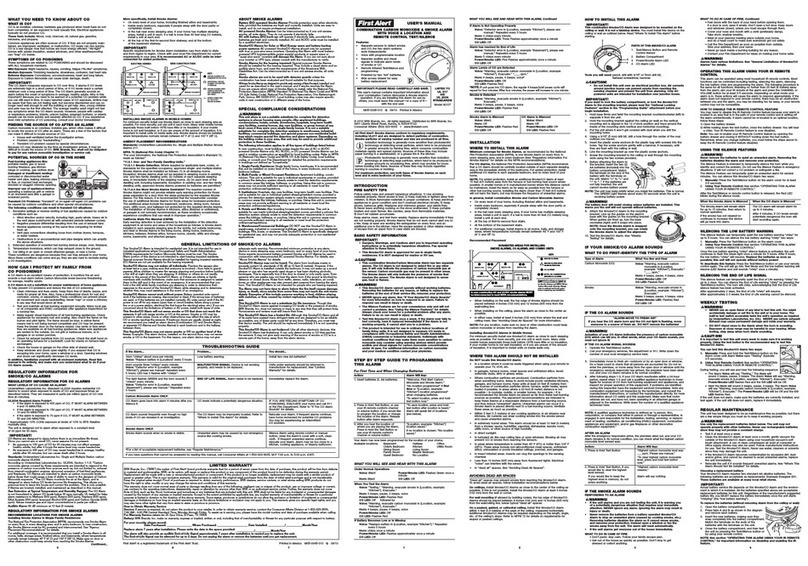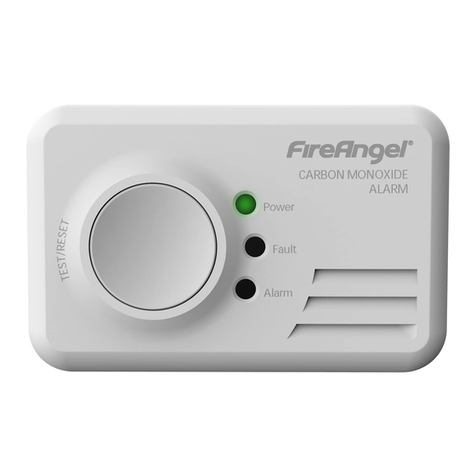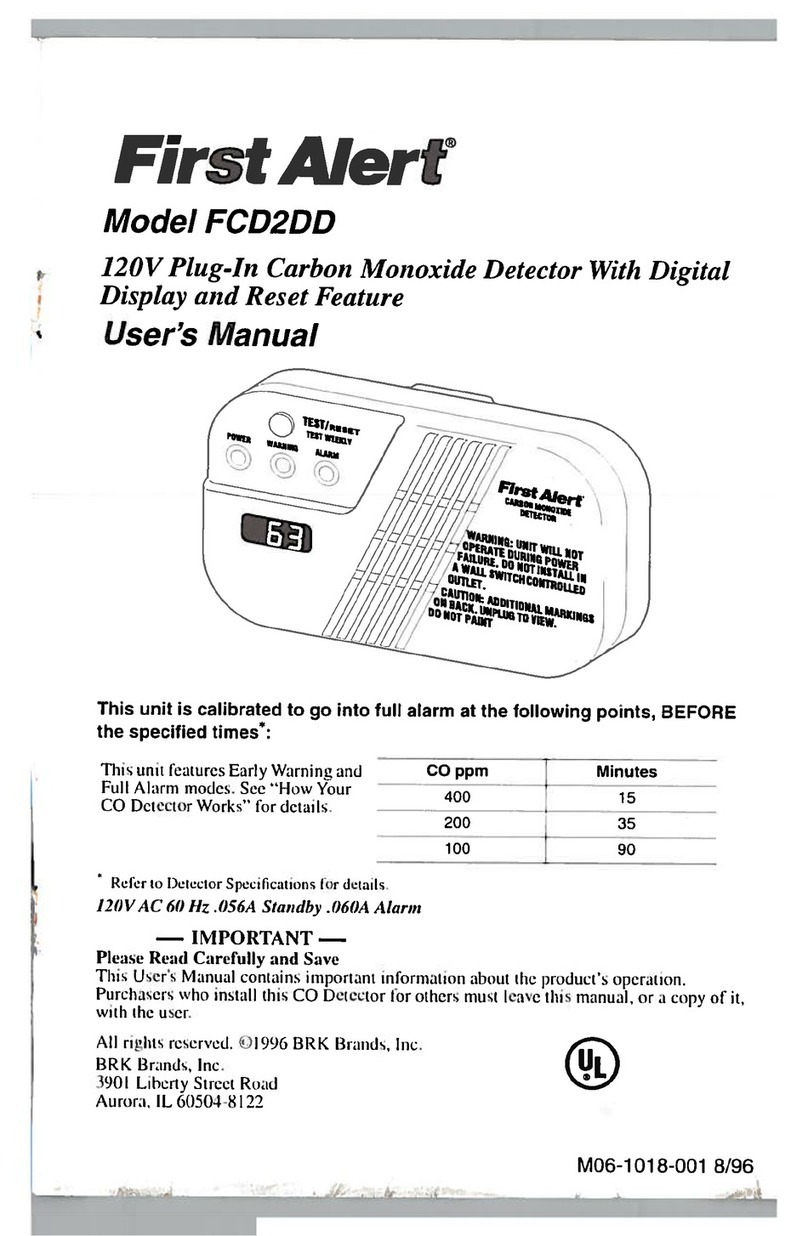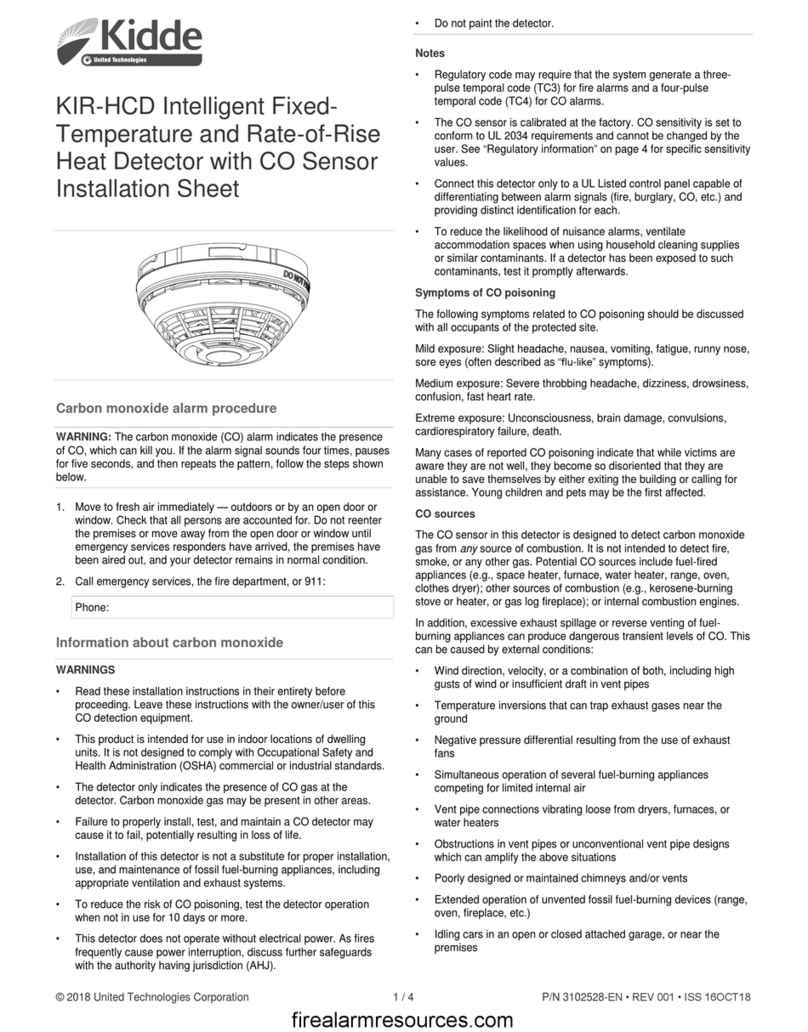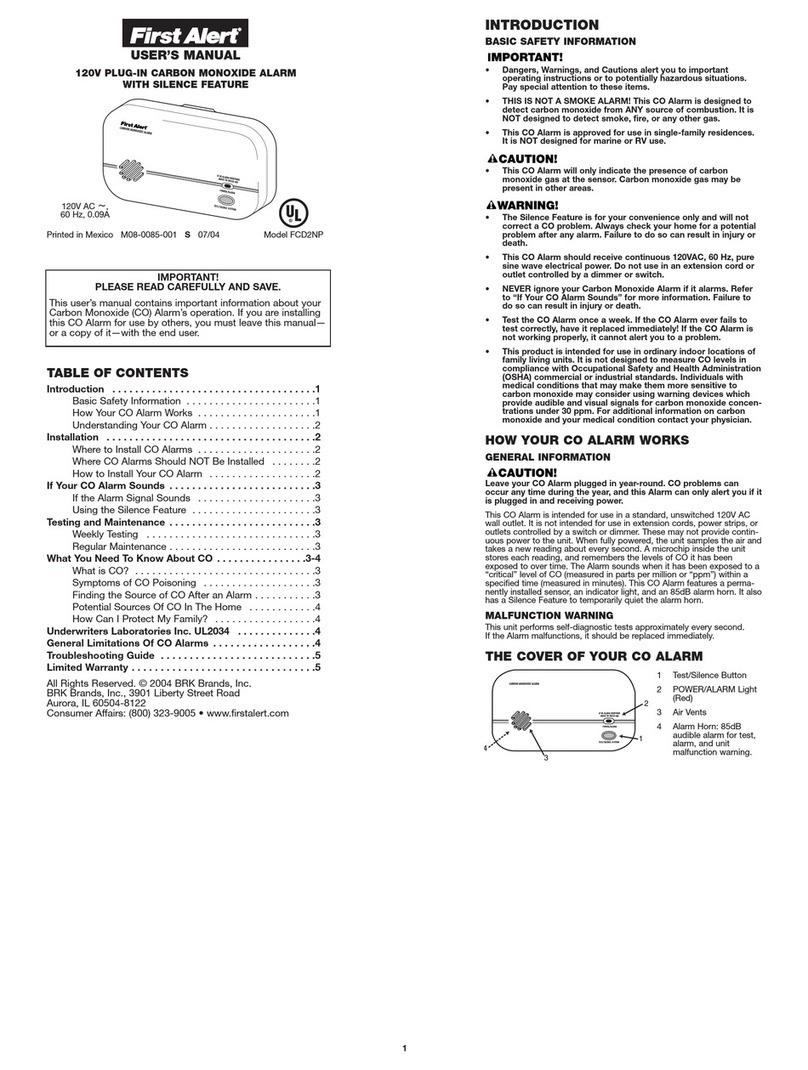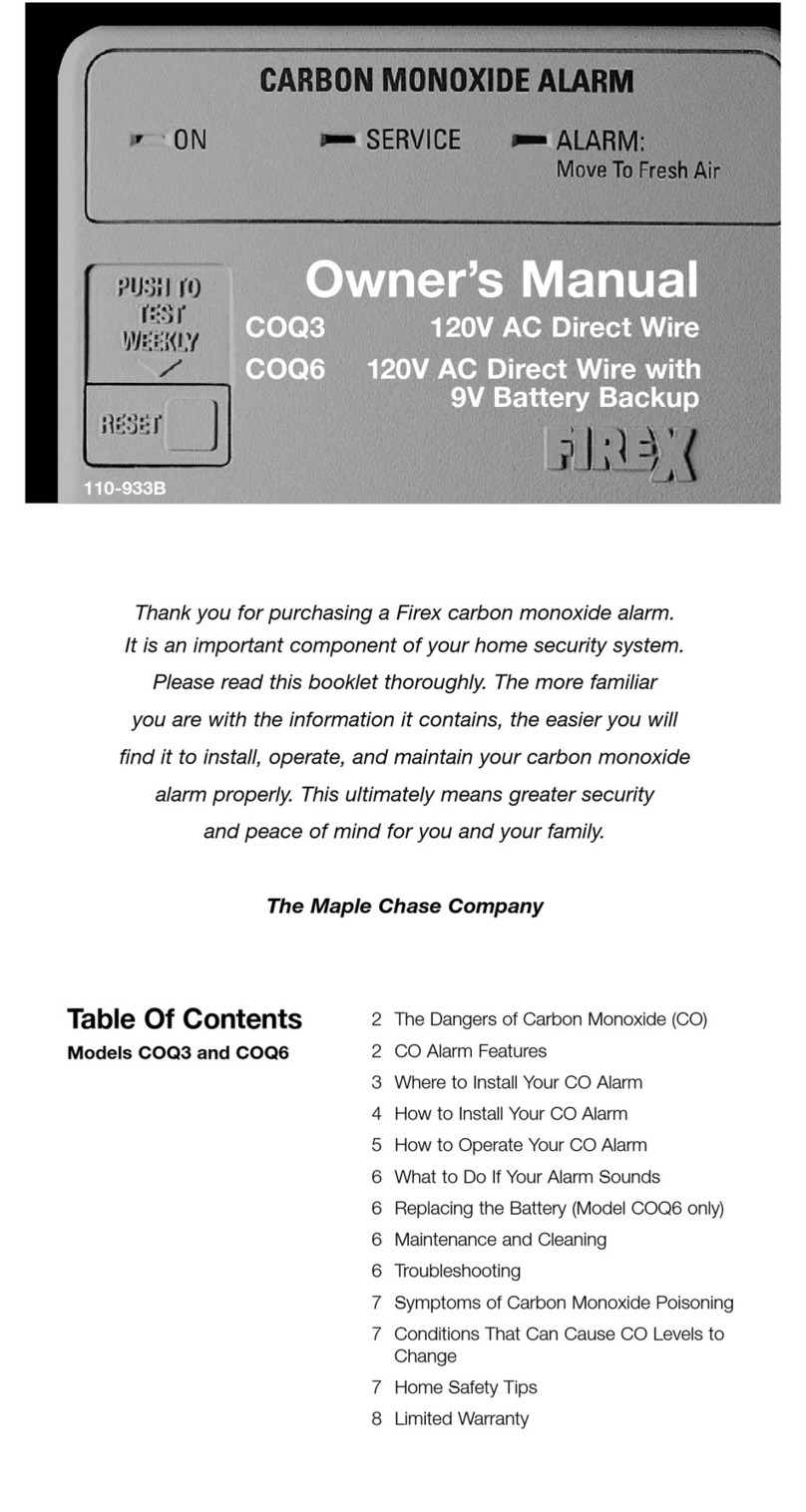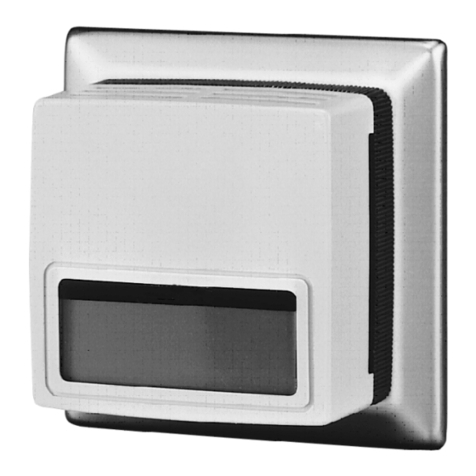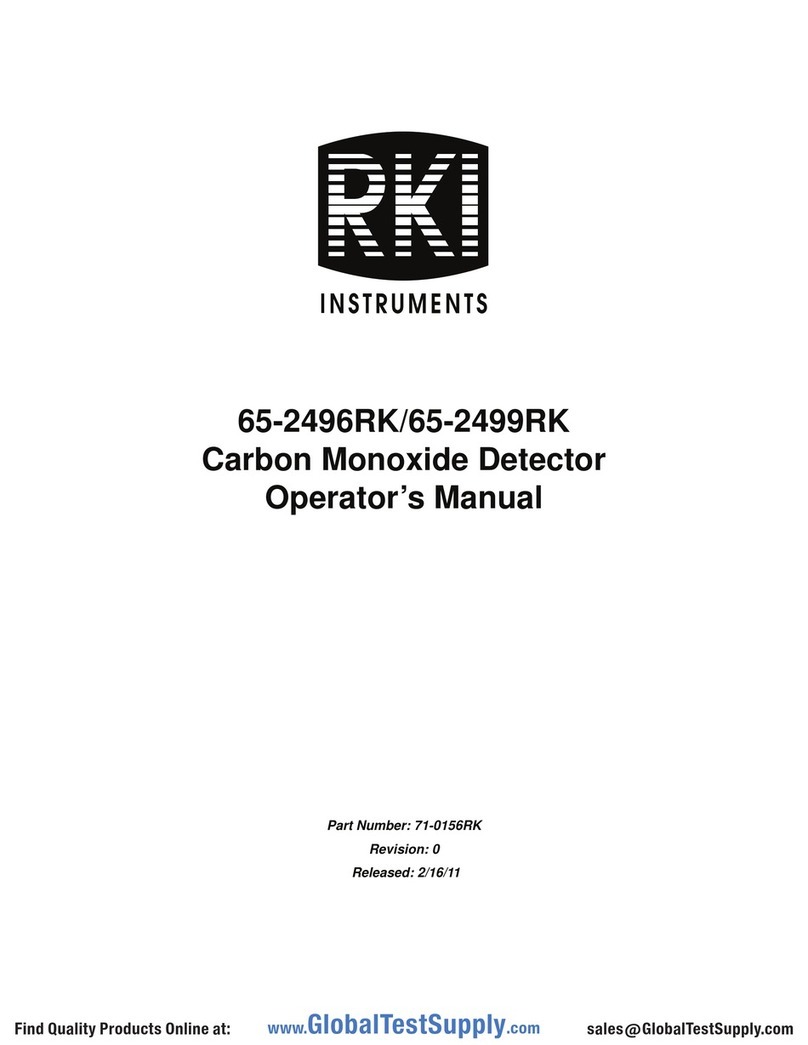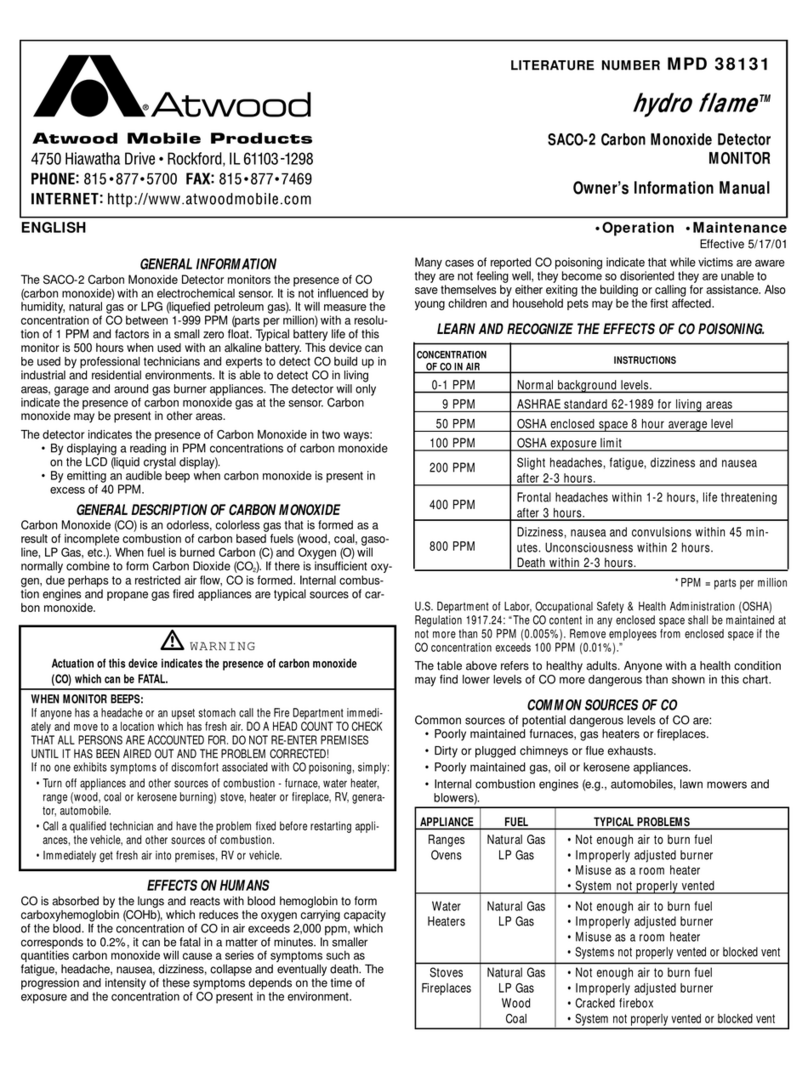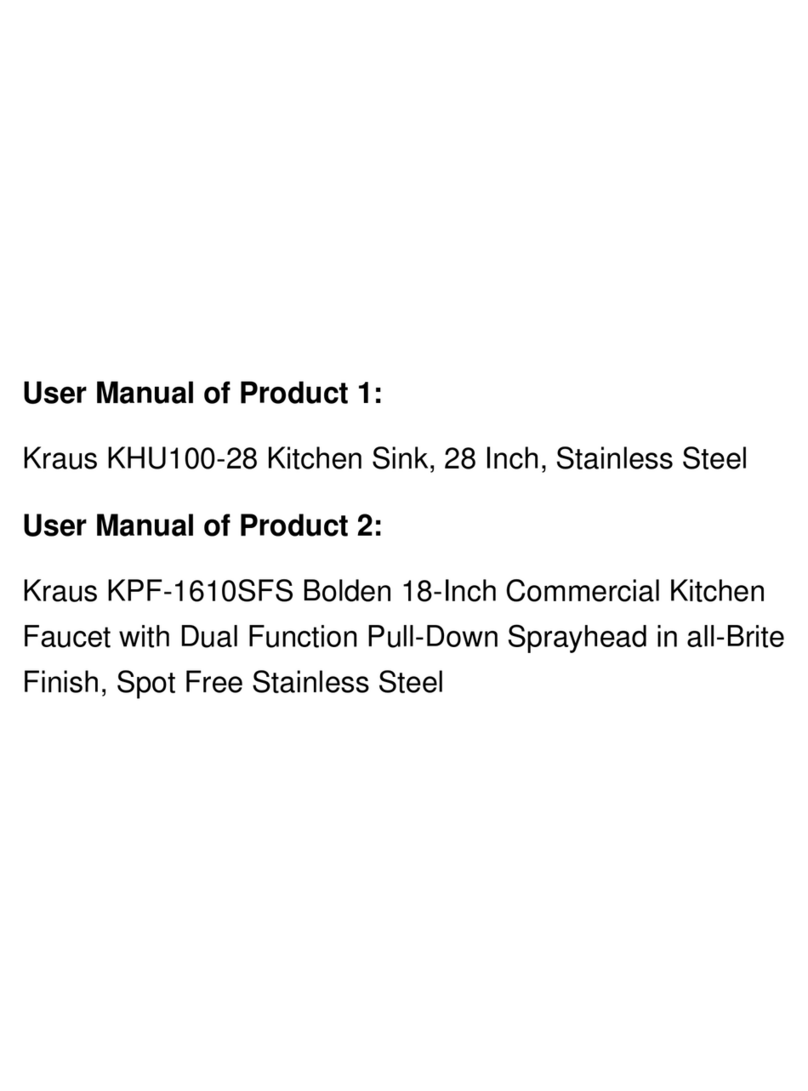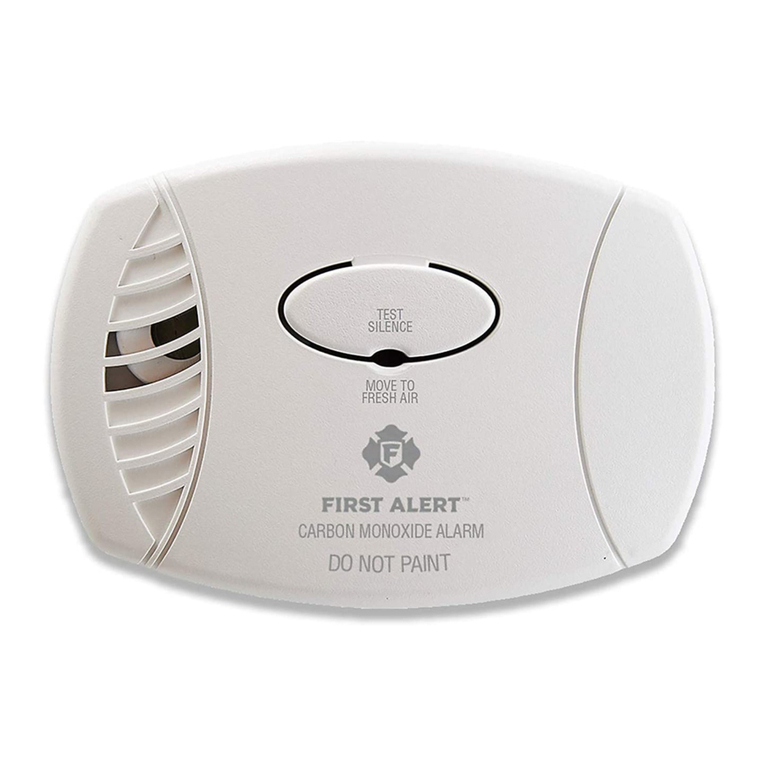3.3 Installation.
The HSE, UK gives more detailed recommendations
as follows:
If locating the CO Alarm in a room with an
appliance:
- the alarm should be located between 1.85m and 3m
horizontally from the appliance.
- the alarm should be located preferably on the ceiling.
Ceiling mounted detectors should be at least 300mm
from any wall.
- if placed on a wall the CO Alarm should be as high
as possible (higher than doors and windows) but not
within 150mm of the ceiling.
If locating the CO Alarm in a room remote from the
appliance:
- the alarm should be located at a level
similar to the breathing zone of the occupant
(typically in the living rooms at 1.5 to 2.0m above floor
level and in bedrooms at the height of the bed).
The BS 7860 : 1996 standard recommends that the CO Alarm should be at
least 1.5 metres (5ft) above floor level, and also the detector should be at
least 1.85 metres (6ft) from the appliance.
INSTALLING CARBON MONOXIDE ALARMS
The Alarm is designed to be permanently mounted, using it s
own built-in terminal block to connect it to the mains. The
mounting plate can be screwed directly to the ceiling.
Alternatively it can be screwed to a standard junction box
(BS 4662 single gang accessory box). It requires a current of
60mA. The Alarm must not be exposed to dripping or
splashing. There are important markings on the underside of
the alarm.
IMPORTANT PRECAUTION: Do not install the actual
alarm itself in new or renovated buildings until all work is
completed (including floor coverings) and the building
has been fully cleaned. The wiring can be installed when
appropriate. (Excessive dust and debris from building
work can contaminate the sensor and cause problems, it
will also invalidate the guarantee). If it must be installed,
cover it completely, particularly around the edges, with a
dust cover, until all cleaning is finished.
The Alarm must not be connected when the house wiring
insulation is being checked with high voltages i.e. don t use a
megger on the alarm.
WARNING: Do not use the CO Alarm on an intermittent basis,
or as a portable detector for the spillage of combustion prod-
ucts from fuel burning appliances or chimneys.
WARNING: Mains operated Alarms should be installed and
interconnected by a qualified electrician in accordance with
the Regulations for Electrical Installations published by the
Institution of Electrical Engineers (UK). Failure to install this
Alarm correctly may expose the user to shock or fire hazards.
WARNING: The Alarm must be continuously powered 24
hours a day so it is important that it is not on a circuit that can
be turned off by a switch.
INSTALLATION
(1) Select a location complying with the above advice.
(2) Disconnect the AC mains supply from the circuit that is
going to be used.
(3) Remove the mounting plate from the CO Alarm by
releasing the tamper-proof catch with a small screwdriver
as shown in Figure 1 and sliding the Alarm from the plate.
(4) The house wiring must be connected to the terminal block
on the mounting plate as follows:
L: Live - connect to the house wires coloured brown, red
or marked L.
N: Neutral - connect to the house wires coloured blue,
black or marked N.
IC: Interconnect - connect to the third core. (If you are
not interconnecting units, do not connect anything to the
IC terminal). See below for information on
interconnecting).
Warning: Mixing Live & Neutral wires will damage
interconnected alarms.
We recommend the use of 6243Y mains cable when
interconnecting units. Use the third core for interconnection.
Do not use an earth wire for the interconnect line.
Lift off the wiring cover as shown in Figure 3.
N.B. The Alarm does not need to be earthed. However the
terminal marked is provided for the convenience of the
installer so that any copper earth wire or cable coloured green
or green & yellow, can be safely terminated.
To interconnect the Alarms connect all the IC terminals
together as shown in Figure 5
(5) If the mains wires are recessed, bring the wires through
the rear hole in the mounting plate as shown in Figure 4
If the mains wires are being brought along the surface, con-
duit can be inserted into the top and/or bottom, for the cable.
(a) position the mounting plate so the cable conduit is as
shown in Figure 4
(b) Carefully cut around the knockout on the outside wall so
the conduit fits. (Note: to comply with the BS 7860, IP42
protection rating, seal around conduit with silicone rubber or
similar to prevent water entering).
(6) Carefully align the mounting plate and screw into place.
Connect the wires to the terminal block. With recessed wiring,
ensure the rear gasket seals around the edge of the hole in
the ceiling or wall. This is to prevent air draughts affecting the
CO gas entering the alarm. If the orifice is not closed off by
the gasket it should be sealed with silicone rubber or equiva-
lent.
Replace the wiring cover.
Carefully line up the unit on the base and slide on.
Press the test/hush button for 10 seconds. The horn will
sound.
CAUTION: Do not attempt to remove the Alarm without first
releasing the tamper clip as shown in Figure 1.
(7) Connect the mains power to the alarm circuit. Check the
green light is on.
Check the operation of the Alarm as outlined below.
(8) The unit may be tamperproofed further, by removing the
knockout in the sidewall of the mounting plate as shown
in Figure 1. Insert the self tapping screw (3mm diameter,
12mm long) after the unit is on the mounting plate
INTERCONNECTING Ei ELECTRONICS CARBON
MONOXIDE ALARMS
When one unit detects CO all units alarm. All horns will sound
but only units detecting CO will flash their red lights.
A maximum of twelve Ei 261/261D CO Alarms may be
interconnected along with an Ei 128C module with relay (see
technical specification).
(If you wish to interconnect more than twelve alarms contact
your distributor). Systems using more than 3 or 4 alarms must
be very carefully planned to ensure nuisance alarms are not
excessive e.g. from weekly testing.
¥All alarms must be cleaned and maintained regularly.
¥A qualified person must be on call to quickly remove any
faulty alarms, which are causing all the alarms to sound.
WARNING: Do not connect these Alarms to any other
type of Ei Alarm, or to any other model produced by
another manufacturer, apart from those listed above.
Doing this may damage the Alarms and could result in a
shock or fire hazard.
The interconnect wire (minimum 0.75mm2cable) must be
treated as if it was live. It should be insulated and sheathed.
A maximum of 250 metres (820 ft) of wire can be used (max-
imum resistance between detectors 50 ohms). Connect as
shown in Figure 5.
These Carbon Monoxide Alarms should be interconnected
only within the confines of a single family living unit. If they are
connected between different units there may be excessive
nuisance alarms. Everybody may not be aware that they are
being tested etc.
4. TESTING YOUR CO ALARM
(1) Regularly check that the green mains power light is on.
The unit cannot detect CO if the mains power is not on and
the rechargeable battery is depleted. (If it is off check circuit
breakers, fuses, wiring etc).
(2) Test the unit weekly by pressing the test/hush button. Hold
the test button for 5 seconds until the horn sounds for over 5
seconds. This will help to familiarise you and your family with
the distinctive on-off sound of the CO Alarm. This test checks
that the electronics and horn are working correctly. If the units
are interconnected, button test each unit in turn and check all
interconnected units alarm.
(3) If the CO Alarm gives a short beep and the amber fault
light flashes every 40 seconds it means the self-checking cir-
cuit may have detected a fault. Press and hold the test/hush
button. If the amber light flashes without the horn sounding,
the sensor is faulty. On the Ei 261D the display will show SF
indicating Sensor Faulty.
(4) If the Alarm fails to operate when the test/hush button is
pressed, disconnect the mains supply at the distribution fuse
board, remove unit from mounting plate for 3 minutes. Put unit
back on mounting plate. Re-connect the mains and try again.
(This procedure resets the microprocessor in the unit).
(5) If the unit beeps every 40 seconds it means the battery is
depleted. (On the Ei 261D with depleted cells, the display will
show CP to remind you to Connect mains Power).
Connect mains (ensure green light is on) to allow cells to
charge.
(6) Once a year check the rechargeable cells by switching
off mains and pressing the test button for 10 seconds. The
horn should sound loudly. Re-connect mains power.
If the CO Alarm fails any of the above tests it must be
replaced immediately (see section 9 Getting the CO Alarm
Serviced ).
The CO Alarm is fully operational and will provide protection
against a build up of Carbon Monoxide gas, 70 seconds after
it is connected to the mains supply.
Testing with Carbon Monoxide.
Pressing the test button causes the unit to check for CO 4
seconds later - this is the Fast CO Test Mode. This eliminates
the long waiting normally required e.g. up to 30 minutes at
150ppm CO and up to 6 minutes at 350ppm CO.
The unit can be tested with CO by using one of the kits that
comes with CO either in a glass phial or aerosol can. Follow
the instructions on the kit but be sure to press the test button
to speed up the CO sampling directly after you expose the
unit to the CO. It is best if possible to inject the CO gas into
the gas entry holes, see Figure 1. When it senses the CO it
will give 3 beeps and the red light will flash as per table B. It
then resets to normal mode. (If unit fails to respond press test
button again as gas can take some
seconds to enter sensor).
The Fast CO Test Mode normally does not activate the mem-
ory function. (This can be checked by pressing the test but-
ton. If the red light flashes continuously indicating CO was
detected, hold the test button for 20 seconds until the red light
stops flashing as the memory resets).
How to distinguish between CO Alarm and Smoke Alarm
Warnings.
The CO Alarm has a distinctive on-off sound of 3 pulses, fol-
lowed by a pause as compared with a typical Smoke Alarm
which has a rapid pulsing sound.
In addition, when your CO Alarm is sounding the red alarm
light in the centre of the cover will be flashing.
Testing both your CO Alarms and Smoke Alarms weekly will
help you and your family to clearly distinguish between them
in an emergency.
5. MAINTAINING YOUR CO ALARM
Clean the outside case by occasionally wiping with a clean
damp cloth, (disconnect the mains supply at the
distribution/fuse board first). Do not use any cleaning agents,
bleaches, detergents or polishes, including those in aerosol
cans. Avoid spraying air fresheners, hair spray, paint or other
aerosols near the CO Alarm. Do not place air fresheners near
the unit.
Use the narrow nozzle of a vacuum cleaner to remove fluff
and other contamination from the cover slots to ensure CO
gas can reach the sensor.
Caution: Do not paint the CO Alarm.
Remove the CO Alarm when decorating. Do not allow water
or dust to contaminate the alarm.
Warning: Do not open or tamper with the CO Alarm. There
are no user serviceable parts inside apart from the sensor
module - see below. This can damage the unit and may
expose the user to shock or fire hazards.
How to disconnect and remove the alarm:
(1) First disconnect the mains supply to the CO Alarm circuit
at the distribution/fuse board.
(2) Remove tamperproofing screw if fitted (see Figure 1).
(3) Release catch as shown in Figure 1 and slide unit off
mounting plate.
SENSOR MODULE REPLACEMENT
Replace the sensor module after 5 years operation (or by
the date on the side of the unit).
It must also be replaced if the amber light flashes and the unit
beeps every 40 seconds. Remove the alarm from the mount-
ing plate as described above. Pull out the sensor module from
the rear. Replace with a new sensor module (Ei 261M)
(Contact Aico or EI Electronics, for your nearest module sup-
plier). Carefully align the module including the three connec-
tor pins and push firmly home. Slide the alarm back on to the
mounting plate. Reconnect the mains supply. Wait 4 minutes
for the new sensor to stabilise and then press the test button
- the horn should sound.
Check the alarm as described in section 4 above.
6. LIMITATIONS OF CO ALARMS
(1) The Ei 261/261D CO Alarm will not work without mains
power if the rechargeable cells are depleted. The green
power light must be on at all times as far as possible.
(2) Carbon Monoxide must enter the unit for it to be detected.
There may be Carbon Monoxide in other areas of the house
(e.g. downstairs, in a closed room etc). but not in the vicinity
of the CO Alarm. Doors, air draughts and obstructions can
prevent the CO reaching the Alarm. For these reasons we
recommend CO Alarms are fitted both near and in bedrooms,
particularly if bedroom doors are closed at night. Additionally
install in rooms where members of the household spend
much of their time, and in rooms with potential sources of CO
gas.
(3) The CO Alarm may not be heard. The sound output is loud
but it may not be heard behind a closed door or if it is too far
away. Interconnecting CO Alarms greatly improves the prob-
ability that they will be heard. The Alarm may not wake up
somebody who has taken alcohol or drugs. The alarm sound
may be masked by other sounds such as T.V., stereo, traffic
noise etc. Fitting CO Alarms on either side of closed doors will
improve their chance of being heard. This CO Alarm is not
designed for people with impaired hearing.
(4) CO Alarms don t last indefinitely. CO Alarms are sophisti-
cated electronic devices with many parts. Although the alarm
and its component parts have undergone stringent tests, and
are designed to be very reliable, it is possible that parts can
fail. Therefore, you should test your CO Alarm weekly. We
recommend that the CO Alarm sensor is replaced after 5
years operation. The complete unit should be replaced after
10 years.
(5) CO Alarms are not a substitute for life insurance. House-
910 11
13 14 15 16
